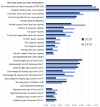Global dietary convergence from 1970 to 2010, despite inequality in agriculture, leaves undernutrition concentrated in a few countries
- PMID: 33997790
- PMCID: PMC7610759
- DOI: 10.1038/s43016-021-00241-9
Global dietary convergence from 1970 to 2010, despite inequality in agriculture, leaves undernutrition concentrated in a few countries
Abstract
Humans globally have similar nutritional needs but face large differences in natural resource endowments and local food production. This study quantifies food system inequality across countries based on natural resource inputs, food/nutrient outputs, and nutrition/health outcomes, from 1970 to 2010. Animal source foods and overweight/obesity show rapid convergence while availability of selected micronutrients demonstrate slower convergence. However, all variables are more equally distributed than national income per capita, whose Gini coefficient declined from 0·71 to 0·65. Inequalities in total and animal-source dietary energy declined from 0·16 to 0·10 and 0·55 to 0·36, respectively. There was convergence in overweight/obesity prevalence from 0·39 to 0·27, while undernutrition and stunting became increasingly concentrated in a few high-burden countries. Characterizing cross-country inequalities in agricultural resources, foods, nutrients, and health can help identify critical opportunities for agriculture and food policies, as well as prioritize research objectives and funding allocation for the coming decade.
Conflict of interest statement
Ethics declaration: The authors declare no competing interests.
Figures







Similar articles
-
The Global Nutrient Database: availability of macronutrients and micronutrients in 195 countries from 1980 to 2013.Lancet Planet Health. 2018 Aug;2(8):e353-e368. doi: 10.1016/S2542-5196(18)30170-0. Lancet Planet Health. 2018. PMID: 30082050 Free PMC article.
-
Health and nutritional aspects of sustainable diet strategies and their association with environmental impacts: a global modelling analysis with country-level detail.Lancet Planet Health. 2018 Oct;2(10):e451-e461. doi: 10.1016/S2542-5196(18)30206-7. Lancet Planet Health. 2018. PMID: 30318102 Free PMC article.
-
The 2023 Latin America report of the Lancet Countdown on health and climate change: the imperative for health-centred climate-resilient development.Lancet Reg Health Am. 2024 Apr 23;33:100746. doi: 10.1016/j.lana.2024.100746. eCollection 2024 May. Lancet Reg Health Am. 2024. PMID: 38800647 Free PMC article. Review.
-
The Relative Caloric Prices of Healthy and Unhealthy Foods Differ Systematically across Income Levels and Continents.J Nutr. 2019 Nov 1;149(11):2020-2033. doi: 10.1093/jn/nxz158. J Nutr. 2019. PMID: 31332436 Free PMC article.
-
Strong nutrition governance is a key to addressing nutrition transition in low and middle-income countries: review of countries' nutrition policies.Nutr J. 2014 Jun 27;13:65. doi: 10.1186/1475-2891-13-65. Nutr J. 2014. PMID: 24970243 Free PMC article. Review.
Cited by
-
Global food nutrients analysis reveals alarming gaps and daunting challenges.Nat Food. 2023 Nov;4(11):1007-1017. doi: 10.1038/s43016-023-00851-5. Epub 2023 Oct 12. Nat Food. 2023. PMID: 37828076
-
Progress towards healthy diets remains slow.Nat Food. 2023 Nov;4(11):937-938. doi: 10.1038/s43016-023-00862-2. Nat Food. 2023. PMID: 37828077 No abstract available.
-
Tracing global flows of bioactive compounds from farm to fork in Nutrient Balance Sheets can help guide intervention towards healthier food supplies.Nat Food. 2022 Sep 19;3(9):703-715. doi: 10.1038/s43016-022-00585-w. Nat Food. 2022. PMID: 36226129 Free PMC article.
-
The feasibility of implementing food-based dietary guidelines and food graphics in Ethiopia.Food Secur. 2023;15(3):805-822. doi: 10.1007/s12571-022-01335-3. Epub 2023 Jan 19. Food Secur. 2023. PMID: 36691456 Free PMC article.
-
Changes in food quality and habits in urban Ghana: evidence from a mixed-methods study.BMC Public Health. 2025 Jul 26;25(1):2556. doi: 10.1186/s12889-025-23751-8. BMC Public Health. 2025. PMID: 40713523 Free PMC article.
References
-
- Hawkes C, Chopra M, Friel S. Globalization, Trade, and the Nutrition Transition. Ch. 10. In: Labonté R, Schrecker T, Packer C, Runnel V, editors. Globalization and Health: Pathways, evidence and policy. 1st. Routledge; New York: 2009.
Grants and funding
LinkOut - more resources
Full Text Sources
Other Literature Sources

